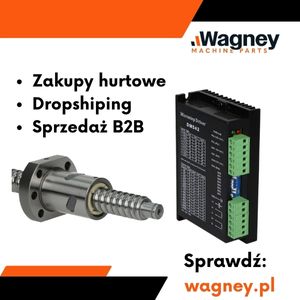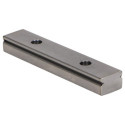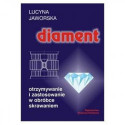Chyba tu:
https://www.cnc.info.pl/topics12/serwos ... f93112409d
Znaleziono 4 wyniki
Wróć do „servo motor AC jaki sterownik”
- 27 cze 2008, 05:50
- Forum: Serwomotory / Serwonapędy / Napędy Serwokrokowe
- Temat: servo motor AC jaki sterownik
- Odpowiedzi: 66
- Odsłony: 29590
- 24 cze 2008, 01:48
- Forum: Serwomotory / Serwonapędy / Napędy Serwokrokowe
- Temat: servo motor AC jaki sterownik
- Odpowiedzi: 66
- Odsłony: 29590
Profesjonalisci wybierają już raczej CAN. Ale i on nie jest doskonały - tak naprawdę nie wierzę że zamiana step/dir na CAN wiele zmienia ( oba mają podobną graniczną częstotliwosć pracy).cnc3d pisze:Różnica pomiędzy systemami sterowania amatorskimi i profesjonalnymi wykorzystującymi serwonwpędy polega na tym, że w tych profesjonalnych nikt nie steruje step/dir itp.
Oba interfejsy tak naprawdę tylko ustalają "żądane położenie", o klasie sterowania będzie decydował jednak głównie użyty algorytm PID ( rzadko kiedy czysty PID jak przy sterowaniach amatorskich). Rozdzielczosć enkodera jest sprawą neutralną na tyle na ile sterowanie jest w stanie przetworzyć np. dużą częstotliwosc impulsów.
Profesjonalisci np. wezmą potężny proceosr DSP ze zmiennym przecinkiem - amatorów nie będzie stać na np. kompilatory i debugger ( sam procesor jest tani ).
[ Dodano: 2008-06-24, 01:56 ]
Hmm, napewno ?? Zawsze mi się wydawało że sterownik CNC zadaje jednak położenie poprzez (step/dir, CAN) bezposrednio do modułu który steruje silnikiem serwo i do którego podłączony jest enkoder. Można oczywicie inaczej, ale wtedy pakujemy się w kłopoty o których kolega mówi ( opóżnienie w sterowaniu przy pojawieniu się uchybu).cnc3d pisze: Zasada jest taka że wszystkie te serwonapędy są sterowane zadaną PRĘDKOŚCIĄ, A NIE POZYCJĄ!!! a regulatora pozycji w ogóle nie ma w serwonapędzie tylko jest w sterowniku cnc. I nie zależy to od tego czy serwonapęd jest analogowy (sterowanie +/-10V) czy cyfrowy. I tak zadawana jest prędkość.
- 18 cze 2008, 12:34
- Forum: Serwomotory / Serwonapędy / Napędy Serwokrokowe
- Temat: servo motor AC jaki sterownik
- Odpowiedzi: 66
- Odsłony: 29590
Mi wolno podać receptę na gotowy sterownik - na szczęscie producenci procesorów uzywanych do sterowania silnikami nie mają obiekcji i publikują przykładowe implementacje wraz z dokumentacją: http://www.freescale.com/files/dsp/doc/ ... umentation
Cytat z rozdziału 5:
"Field-oriented control is commonly called vector control. This control method will maintain
near-perpendicular stator flux and rotor flux by keeping the sum of stator fluxes constant. When the
control axis is coincident with the stator flux, the stator flux in the load angle can be calculated from the
stator current and the motor constants. When attempts are made to control this calculated stator flux at
the same magnitude as the permanent magnet flux, the error in the flux can be calculated from the stator
flux and the load angle. This makes it possible to construct a control system by feeding back the flux
phase current calculation to the stator voltages for the various axes of the Permanent Magnet
Synchronous Motor (PMSM), with the control axis coincident with the stator flux, producing a control
voltage command. This voltage command is applied to the PMSM at the described frequency. Although
the vector control method can achieve high performance and efficiency, it is based on the accuracy of
the motor constants’ values. The variation of motor internal resistance and inductance by temperature
can decrease the system’s performance and efficiency. To compensate for parameter variations,
complex parameter observation and control algorithms are needed to correct those errors. On other
hand, the field-oriented control method is often applied to PMSM motors with a sinusoidal back-EMF
waveform shape to achieve high torque performance and efficiency. Figure 5-1 shows a sensorless
PMSM vector control system.
The field-oriented controller is based on a current-controlled voltage source inverter structure. The
current control loops are arranged in the 2-phase synchronously rotating reference frame d-q aligned
with rotor flux, while the rotor position and speed detection operates in the 2-phase stationary reference
frame αβ.
During normal operations, the output of the speed regulator represents the q axis reference current, iq,
while the d axis reference current, id, is set to zero in order to maximize the torque-to-current ratio of the
PMSM. The outputs of the current regulators represent the reference voltages in the rotating reference
frame. A d-q to αβ transformation then yields the reference voltage values in the stator reference frame,
which are the inputs of a Space Vector Pulse Width Modulator (SVPWM).
Current feedback is obtained by measuring the 3-phase currents and the successive transformations to
the stator and rotor components, respectively. The stator current components are used inside the
observer, while the rotor current components are needed for current regulation. Standard PI controllers,
with limitation, are used for all regulators.
The combined Sliding Mode Observer (SMO) and low-pass filter provide the rotor position used for the
field orientation and the rotor speed feedback used for the speed control loop.
Brushless DC (BLDC) systems combine the positive attributes of AC and DC systems. In contrast to a
brush DC motor, motors conventionally used for a BLDC system are a type of permanent magnet AC
synchronous motors with a trapezoidal back-EMF waveform shape and electronic commutation replaces
the mechanical brushes in the DC motor. Although this control method will generate torque glitches
during phase commutation, it satisfies most applications in which rotor speed is the control target.
PMSM motors with a sinusoidal back-EMF waveform shape can also be used in a BLDC system. But the
phasor angle between stator flux and rotor flux are maintained between 60° electrical and 120°
electrical. Torque ripples will occur during operation, but average torque will remain constant, meeting
the requirements of most low-end applications.
The information from back-EMF zero crossing can be used to determine the rotor position for proper
commutation and to determine which power transistors to turn on to obtain maximum motor torque. The
cheapest and the most reliable method to sample back-EMF zero crossing information is to feed the
resistor network samples’ back-EMF signal into ADC inputs or GPIOs.
In sensored control structure, phases are commutated once every 60° electrical rotation of the rotor.
This implies that only six commutation signals are sufficient to drive a BLDC motor. Furthermore,
efficient control implies a synchronization between the phase Bemf and the phase supply so that the
Bemf crosses zero once during the non-fed 60° sector.
As only two currents flow in the stator windings at any one time, two phase currents are opposite and the
third phase is equal to zero. Knowing that the sum of the three stator currents is equal to zero
(star-wound stator), the anticipated instantaneous Bemf waveforms can be calculated. The sum of the
three stator terminal voltages is equal to three times the neutral point voltage (Vn). Each of the Bemfs
crosses zero twice per mechanical revolution, and as the Bemfs are numerically easy to compute,
thanks to the signal processing capability of the 56F8013, it is possible to get the six required items of
information regarding the commutation."
Ja zrozumiałem to w nastepujący sposób - faktycznie PMSM oraz BLDC mają pewne różnice w budowie (choć nie doszedłem jakie) które powodują, że Bemf ma nieco inny kształt (sinus versus trapez). W przypadku sterowania "sensorless" ( tak jak w tym papierze) ma to poważne konsekwencje, bo dla PMSM estymowane jest kątowe położenie rotora, dla BLDC zas tylko 60deg strefa komutacji. Przy takim podejsciu faktycznie zamiana pomiędzy silnikami (PMSM/BLDC) i sterowaniami bedzie nieoptymalna ( i bedzie tak jak kolega cnc3d opisywał).
Tyle że w naszym przypadku ( serwo) zawsze mamy enkoder/resolver, więc dobrze znamy położenie rotora. Dzięki temu mozna będzie w zasadzie zapomnieć o bemf i optymalnie sterować polem magnetycznym (niezależnie czy mamy PMSM czy BLDC). Z opisów Piotrjub'a zrozumiałem że jego sterownik BLDC włanie tak działa - bardzo chwalił stabilnosć napędu pracującego w takich warunkach. Dla takiego sterownika nie widzę już róznic w osiągach niezależnie czy podłączymy mu PMSM czy BLDC (tak jak opisuje to kolega Leoo) - jeżeli się mylę to czy możecie wskazać gdzie ?
Cytat z rozdziału 5:
"Field-oriented control is commonly called vector control. This control method will maintain
near-perpendicular stator flux and rotor flux by keeping the sum of stator fluxes constant. When the
control axis is coincident with the stator flux, the stator flux in the load angle can be calculated from the
stator current and the motor constants. When attempts are made to control this calculated stator flux at
the same magnitude as the permanent magnet flux, the error in the flux can be calculated from the stator
flux and the load angle. This makes it possible to construct a control system by feeding back the flux
phase current calculation to the stator voltages for the various axes of the Permanent Magnet
Synchronous Motor (PMSM), with the control axis coincident with the stator flux, producing a control
voltage command. This voltage command is applied to the PMSM at the described frequency. Although
the vector control method can achieve high performance and efficiency, it is based on the accuracy of
the motor constants’ values. The variation of motor internal resistance and inductance by temperature
can decrease the system’s performance and efficiency. To compensate for parameter variations,
complex parameter observation and control algorithms are needed to correct those errors. On other
hand, the field-oriented control method is often applied to PMSM motors with a sinusoidal back-EMF
waveform shape to achieve high torque performance and efficiency. Figure 5-1 shows a sensorless
PMSM vector control system.
The field-oriented controller is based on a current-controlled voltage source inverter structure. The
current control loops are arranged in the 2-phase synchronously rotating reference frame d-q aligned
with rotor flux, while the rotor position and speed detection operates in the 2-phase stationary reference
frame αβ.
During normal operations, the output of the speed regulator represents the q axis reference current, iq,
while the d axis reference current, id, is set to zero in order to maximize the torque-to-current ratio of the
PMSM. The outputs of the current regulators represent the reference voltages in the rotating reference
frame. A d-q to αβ transformation then yields the reference voltage values in the stator reference frame,
which are the inputs of a Space Vector Pulse Width Modulator (SVPWM).
Current feedback is obtained by measuring the 3-phase currents and the successive transformations to
the stator and rotor components, respectively. The stator current components are used inside the
observer, while the rotor current components are needed for current regulation. Standard PI controllers,
with limitation, are used for all regulators.
The combined Sliding Mode Observer (SMO) and low-pass filter provide the rotor position used for the
field orientation and the rotor speed feedback used for the speed control loop.
Brushless DC (BLDC) systems combine the positive attributes of AC and DC systems. In contrast to a
brush DC motor, motors conventionally used for a BLDC system are a type of permanent magnet AC
synchronous motors with a trapezoidal back-EMF waveform shape and electronic commutation replaces
the mechanical brushes in the DC motor. Although this control method will generate torque glitches
during phase commutation, it satisfies most applications in which rotor speed is the control target.
PMSM motors with a sinusoidal back-EMF waveform shape can also be used in a BLDC system. But the
phasor angle between stator flux and rotor flux are maintained between 60° electrical and 120°
electrical. Torque ripples will occur during operation, but average torque will remain constant, meeting
the requirements of most low-end applications.
The information from back-EMF zero crossing can be used to determine the rotor position for proper
commutation and to determine which power transistors to turn on to obtain maximum motor torque. The
cheapest and the most reliable method to sample back-EMF zero crossing information is to feed the
resistor network samples’ back-EMF signal into ADC inputs or GPIOs.
In sensored control structure, phases are commutated once every 60° electrical rotation of the rotor.
This implies that only six commutation signals are sufficient to drive a BLDC motor. Furthermore,
efficient control implies a synchronization between the phase Bemf and the phase supply so that the
Bemf crosses zero once during the non-fed 60° sector.
As only two currents flow in the stator windings at any one time, two phase currents are opposite and the
third phase is equal to zero. Knowing that the sum of the three stator currents is equal to zero
(star-wound stator), the anticipated instantaneous Bemf waveforms can be calculated. The sum of the
three stator terminal voltages is equal to three times the neutral point voltage (Vn). Each of the Bemfs
crosses zero twice per mechanical revolution, and as the Bemfs are numerically easy to compute,
thanks to the signal processing capability of the 56F8013, it is possible to get the six required items of
information regarding the commutation."
Ja zrozumiałem to w nastepujący sposób - faktycznie PMSM oraz BLDC mają pewne różnice w budowie (choć nie doszedłem jakie) które powodują, że Bemf ma nieco inny kształt (sinus versus trapez). W przypadku sterowania "sensorless" ( tak jak w tym papierze) ma to poważne konsekwencje, bo dla PMSM estymowane jest kątowe położenie rotora, dla BLDC zas tylko 60deg strefa komutacji. Przy takim podejsciu faktycznie zamiana pomiędzy silnikami (PMSM/BLDC) i sterowaniami bedzie nieoptymalna ( i bedzie tak jak kolega cnc3d opisywał).
Tyle że w naszym przypadku ( serwo) zawsze mamy enkoder/resolver, więc dobrze znamy położenie rotora. Dzięki temu mozna będzie w zasadzie zapomnieć o bemf i optymalnie sterować polem magnetycznym (niezależnie czy mamy PMSM czy BLDC). Z opisów Piotrjub'a zrozumiałem że jego sterownik BLDC włanie tak działa - bardzo chwalił stabilnosć napędu pracującego w takich warunkach. Dla takiego sterownika nie widzę już róznic w osiągach niezależnie czy podłączymy mu PMSM czy BLDC (tak jak opisuje to kolega Leoo) - jeżeli się mylę to czy możecie wskazać gdzie ?
- 21 maja 2008, 22:20
- Forum: Serwomotory / Serwonapędy / Napędy Serwokrokowe
- Temat: servo motor AC jaki sterownik
- Odpowiedzi: 66
- Odsłony: 29590











